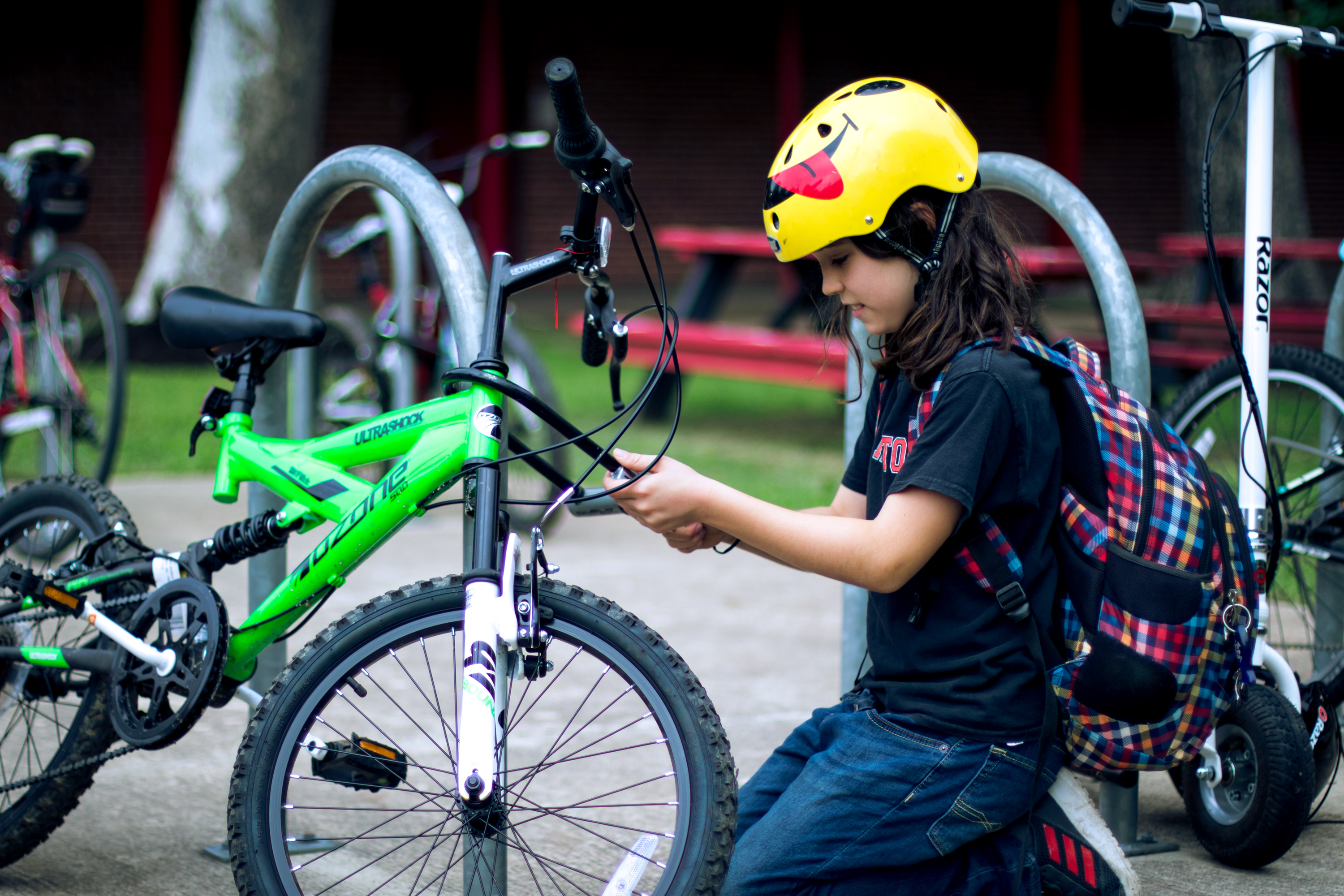Walk to School Day 2022
Published: October 12, 2022

Wednesday, October 12, 2022 is Walk to School Day, an international event that takes place annually on the second Wednesday of October in which children and families from over 40 countries walk or bike to school on the same day.
Active commuting to and from school (ACS) is a meaningful source of physical activity in children and has the potential to contribute substantially to helping children meet the Physical Activity Guidelines for Americans of 60 minutes of moderate to vigorous physical activity (MVPA) per day (1, 2). Studies have shown that children who actively commute to school are more physically active than children who commute by vehicle (3, 4).
Despite the health benefits of ACS (5), walking or biking to school has decreased over time. An estimated 41% of students walked or biked to school in 1969, but by 2001, that number dropped to 13% (6). The STREETS Study (Safe Travel Environment Evaluation in Texas Schools) at UTHealth Houston School of Public Health Austin Campus, funded by National Institutes of Child Health and Human Development (NICHD), is a natural experiment evaluating the City of Austin Safe Routes to School (SRTS) Program and its effectiveness. Baseline data from the STREETS Study from 85 schools in central Texas during the 2018-2019 and 2019-2020 school years, representing 19,405 3rd to 5th grade students (ages 8-10 years of age) found that 14.3% of trips to and from school were made by walking or biking (7). This is slightly higher than national data from 2017 showing that 9.6% of school-aged children walk to school on a regular basis, while an additional 1.1% bicycle (8).
Safety and the Environment
The condition of streets, sidewalks and other structural features on your route to school make a difference in how safe families feel walking or riding to and from school. The STREETS Study interviewed parents, children, and school administrators in Central Texas who noted unsafe conditions on their sidewalks and streets, including trip hazards, lack of proper bike lanes, or parked car interference. Many parents believed the streets could be improved by putting in speed bumps. School personnel frequently noted major safety barriers--including traffic, wide roads, and a lack of crosswalks--that they believe prevent many kids from walking and biking.
In contrast, school administrators expressed their belief that walking and biking to their school is generally safe, but this varied by neighborhood. STREETS Study analysis also found that low-resource communities, with an average of >80% economically disadvantaged students, need significantly more funding to achieve optimal and equitable safe routes to school infrastructure (9).
Why just one day? Creating a culture of active commuting
Of course, just one day of walking to school is not enough! Communities with an active commuting culture not only have healthier kids, but it also allows parents to avoid drop off/pick up lines and traffic, in addition to extra family and peer time outside.
How can you create a culture of walking and biking to and from school in your community? Some ways to support a walking/biking culture are through parent/caregiver education, walking school buses, bike trains, bicycle skills clinics, bicycle and helmet giveaways, and parent- and community-driven initiatives like “park a Block and Walk” or BOW/WOW (Bike on Wednesday/Walk on Wednesday).
Your local municipality or school district may have programs and resources available to you and your school community. Some public works departments, like the City of Austin’s Safe Routes to School , have educational resources and programs including bike rodeos and safety patrol trainings as well as other engagement support, like how to start your own walking school bus or bike train. The US Department of Transportation and Vision Zero both have guides for how the community can get involved in improving the route to/from school.
The Michael & Susan Dell Center for Healthy Living created this resource illustrating how kids in Texas Want to Walk the Walk and offers recommendations to address safety concerns and promote healthy communities.
References
- Services USDoHaH. Healthy People 2020 2017 [Available from: https://www.healthypeople.gov/2020/topics-objectives/topic/physical-activity/objectives.
- Davison KK, Werder JL, Lawson CT. Children’s active commuting to school: current knowledge and future directions. Prev Chronic Dis. 2008;5(3):A100.
- Larouche R, Saunders TJ, Faulkner GEJ, Colley R, Tremblay M. Associations between active school transport and physical activity, body composition, and cardiovascular fitness: a systematic review of 68 studies. Journal of Physical Activity and Health. 2014;11(1):206-27.
- Dalene KE, Anderssen SA, Andersen LB, Steene-Johannessen J, Ekelund U, Hansen BH, et al. Cross-sectional and prospective associations between sleep, screen time, active school travel, sports/exercise participation and physical activity in children and adolescents. BMC public health. 2018;18(1):705.
- 5. Henriques-Neto D, Peralta M, Garradas S, Pelegrini A, Pinto AA, Sánchez-Miguel PA, et al. Active Commuting and Physical Fitness: A Systematic Review. International Journal of Environmental Research and Public Health. 2020;17(8):2721.
- McDonald NC. Active transportation to school: trends among U.S. schoolchildren, 1969-2001. Am J Prev Med. 2007;32(6):509-16.
- Hoelscher, D.M.; Ganzar, L.A.; Salvo, D.; Kohl, H.W., III; Pérez, A.; Brown, H.S.; Bentley, S.S.; Dooley, E.E.; Emamian, A.; Durand, C.P. Effects of large?scale municipal Safe Routes to School infrastructure on student active travel and physical activity: design, methods and baseline data of the Safe Travel Environment Evaluation in Texas Schools (STREETS) natural experiment. Int. J. Environ. Res. Public Health 2022, 19, 1810. https:// doi.org/10.3390/ijerph19031810
- Kontou E, McDonald NC, Brookshire K, Pullen-Seufert NC, LaJeunesse S. US active school travel in 2017: prevalence and correlates. Preventive medicine reports. 2020;17:101024.
- Ganzar, L.A., Bentley, S.S., Salvo, D., Durand, C.P., Anderson, A., Emamian, A., Hoelscher, D.M. Incorporating equity into active commuting to school infrastructure projects: A case study. Transportation Research Part D: Transport and Environment (Accepted 10/5/22)


